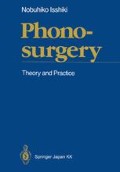Abstract
As mentioned above, voice production at its final stage is a purely mechanical phenomenon, in which several parameters are involved. Cardinal among them are: (a) subglottal pressure; (b) initial or neutral glottal area, or glottal area at resting position AgO; (c) stiffness of the vocal cords; (d) coupling between the upper (cranial) and lower (caudal) portion of the vocal cord edge, which corresponds to the mobility of the vocal cord mucosa; (e) mass of the vocal cord in vibration, the upper and lower portion considered separately.
Access this chapter
Tax calculation will be finalised at checkout
Purchases are for personal use only
Preview
Unable to display preview. Download preview PDF.
Bibliography
3. Pathophysiology of Voice Production
Dunker E, Schlosshauer B (1964) Irregularities of the laryngeal vibratory pattern in healthy and hoarse persons. In: Brewer DW (ed) Research potentials in voice physiology (International Conference, State University of New York). University Publishers, New York, pp 151–184
Hirano M (1975) Phonosurgery. Basic and clinical investigations. Otologia (Fukuoka) 21 [Suppl 1]: 239–442 (in Japanese)
Hiroto I (1966) Patho-physiology of the larynx from the standpoint of vocal mechanism. Pract Otol (Kyoto) 59: 229–294 (in Japanese)
Ishizaka K, Isshiki N (1976) Computer simulation of pathological vocal cord vibration. J Acoust Soc Am 60: 1193–1198
Isshiki N, von Leden H (1964) Hoarseness: aerodynamic studies. Arch Otolaryngol 80: 206–213
Isshiki N, Yanagihara N, Morimoto M (1966) Approach to the objective diagnosis of hoarseness. Folia Phoniatr 18: 393–400
Isshiki N, Tanabe M, Ishizaka K, Broad D (1977) Clinical significance of asymmetrical vocal cord tension. Ann Otol Rhinol Laryngol 86: 58–66
Isshiki N, Kitajima K, Kojima H, Harita Y (1978) Turbulent noise in dysphonia. Folia Phoniatr 30: 214–224
Isshiki N (1980) Recent advances in phonosurgery. Folia Phoniatr 32: 119–154
Klingholz F, Martin F (1983) Speech wave aperiodicities at sustained phonation in functional dysphonia. Folia Phoniatr 35: 322–327
Matsushita H (1969) Vocal cord vibration of excised laryngEs—a study with ultra-highspeed cinematography. Otologia (Fukuoka) 15: 127–142 (in Japanese)
Moore P, Thompson CL (1965) Comments on physiology of hoarseness. Arch Otolaryngl (Chicago) 81: 97–102
Moore P (1976) Observation on laryngeal disease, laryngeal behavior and voice. Ann Otol Rhinol Laryngol 85: 553–564
Meyer-Eppler W (1953) Zum Erzeugungsmechanismus der Geräuschlaute. Z Phonet 7: 196–212
Palmer JM (1956) Hoarseness in laryngeal pathology: Review of literature. Laryngoscope 66: 500–516
Saito S (1977) Phonosurgery. Otologia (Fukuoka) 23 [Suppl 1]: 171–384 (in Japanese)
Sonninen A (1970) Phoniatrie viewpoints on hoarseness. Acta Otolaryngol 263: 68–81
Tanabe M, Isshiki N, Kitajima K (1972) Vibratory pattern of the vocal cord in unilateral paralysis of the cricothyroid muscle. Acta Otolaryngol 74: 339–345
Tanabe M, Isshiki N, Sawada M (1979) Damping ratio of the vocal cord. Folia Phoniatr 31: 27–34
van den Berg Jw, Tan TS (1959) Results of experiments with human laryngEs. Pract Oto Rhino Lar 21: 425–450
von Leden H (1958) Clinical significance of hoarseness and related voice disorders. J Lancet 78: 50–53
von Leden H, Moore P, Timcke R (1960) Laryngeal vibrations: measurement of glottic wave, part III. Pathologic larynx. Arch Otolaryngol 71: 16–35
von Leden H, Moore P (1961) Vibratory pattern of vocal cords in unilateral laryngeal paralysis. Acta Otolaryngol (Stockholm) 53: 493–506
Yanagihara N (1967a) Hoarseness: investigation of the physiological mechanisms. Ann Oto Rhinol Laryngol 76: 472–488
Yanagihara N (1967b) Significance of harmonic changes and noise components in hoarse ness. J Speech Hear Res 10: 531–541
Zinn W (1945) Significance of hoarseness Ann Otol Rhinol Laryngol 54: 136–138
Author information
Authors and Affiliations
Rights and permissions
Copyright information
© 1989 Springer Japan
About this chapter
Cite this chapter
Isshiki, N. (1989). Pathophysiology of Voice Production. In: Phonosurgery. Springer, Tokyo. https://doi.org/10.1007/978-4-431-68358-2_3
Download citation
DOI: https://doi.org/10.1007/978-4-431-68358-2_3
Publisher Name: Springer, Tokyo
Print ISBN: 978-4-431-68360-5
Online ISBN: 978-4-431-68358-2
eBook Packages: Springer Book Archive

